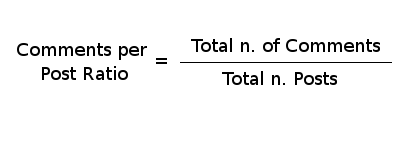Ratio Analysis For Bloggers 2: Comments per Post Ratio
On the first part of this series we talked about the Subscriber Conversion Ratio (and also about the usefulness of ratios for several types of analysis, check it out if you want some basic information on that).
On this post we are going to cover the Comments per Post Ratio.
Why Are Comments Important?
First things first, why should a blogger even care about the number of comments on his blog? There are several reasons for it.
The comments themselves might become a valuable part of your content, and a reason why readers visit your blog. Commentators will often expand your thoughts, complement specific topics and offer another point of view, enriching your articles.
Secondly, the comments section of a blog is the corner stone of the community around it. That is where readers will interact both with the author and with other readers. And as you probably know, the more active and engaged the community on your blog, the higher its popularity.
Finally, first time visitors and potential advertisers might judge the success of your blog based on the average number of comments that it receives. Suppose an advertiser wants to buy a banner ad, and he needs to decide between two blogs on the same topic and with a similar number of RSS subscribers. The first blog, however, gets on average 30 comments per post, while the second gets only 5. Which blog do you think will be chosen?
Comments per Post Ratio
Now that you know the importance of comments, let’s talk about the Comments per Post Ratio (CPR). This is a very simple number, which can be obtained by dividing the total number of comments on your blog by the total number of posts published.

Most blogging platforms display this information on the control panel or on the dashboard. Suppose you have 100 comments and 50 posts published. In this case your CPR would be 2.
Applying the Numbers
In order to give you more concrete examples I will calculate the CPR on my 3 “Daily” blogs.
- Daily Bits has 1,107 total comments and 208 published posts. The CPR is 5,3
- Daily Writing Tips has 4,688 total comments and 486 published posts. The CPR is 9,6
- Daily Blog Tips has 24,931 total comments and 861 published posts. The CPR is 28,9
As you can see there is a good spread on the numbers. Daily Bits gets on average 5,3 comments per post, while Daily Blog Tips gets 28,9.
What factors might be influencing this ratio? Here are some:
1. Posting Frequency. A blog that posts once a week will tend to have a higher number of comments post than a blog that posts daily. The reason is connected to the amount of time that each post will have on top of the homepage (where they receive more visibility and therefore more comments).
2. Topic. The topic of the blog will also influence the Comments per Post Ratio. technology blogs tend to get a smaller number of comments than make money online blogs, for example.
3. Traffic. The higher the traffic, the higher the number of comments per post. That is why many advertisers consider this number as well.
4. Writing style and type of posts. Writers that manage to engage their audience will inevitably receive more comments per post. Additionally, bloggers that know how to get their readers involved can significantly boost the discussion on the comments section.
Conclusion
This ratio can be practically used when you make comparisons with a blog that is in your niche and has a similar level of traffic. If your Comments per Post Ratio is significantly lower than that of another blog, you are doing something wrong.
There are several methods and tactics that you could use to boost the number of comments on your blog (without getting more traffic, changing the topic or the posting frequency), including:
- Asking questions to your readers at the end of posts
- Running polls
- Writing about personal experiences and encourage readers to share theirs
- Writing about polemic issues
- Giving prizes to people that leave comments
- Rewarding your most active commenters with a link
What is the Comments per Post Ration on your blog? Do you think you should try to improve it?

Posting Komentar